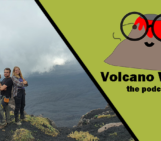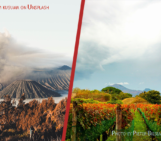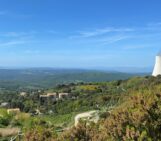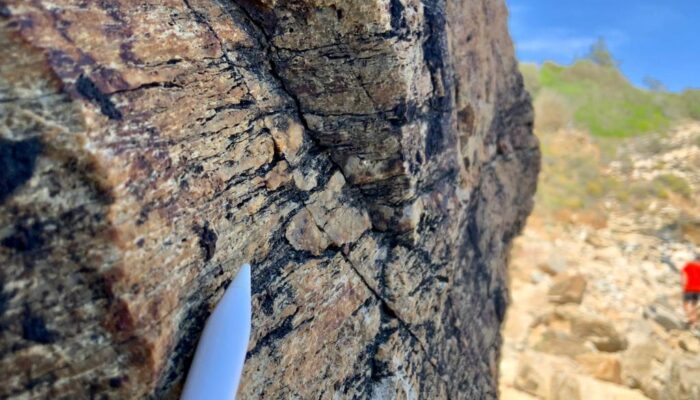
Geothermal resource development faces a major obstacle: the expensive exploration process. Unsuccessful drilled wells can discourage interest and disrupt economic plans. Understanding the relationship between geologic structures and geothermal fluid flow is critical to successful exploration. Various methods, such as geochemistry, geophysics, structural analysis and modeling, aim to create a reliable model to guide exploration plans.
Studying both exhumed and active geothermal systems becomes fundamental to reduce uncertainties and to build pre-drilling models. This approach, using past systems as a basis for studying current ones, improves reliability and also provides field and laboratory insights into geological and fluid dynamics, linking theory to reality.
What is a “fossil” geothermal system?
A fossil geothermal system, revealed through mineralized fractures, geological bodies, and exposed granitoids, provides insights into the deep roots of geothermal systems. It aids in understanding the relationship between geological structures and the pathways of geothermal fluids at depth, represented by hydrothermal veins and mineralized bodies (Tanelli et al., 2001; Zucchi et al., 2017). For a fossil geothermal system to serve as an analogue to an active one, certain conditions must be met: both systems should share the same tectonic context (Carmignani et al., 1995; Dini et al., 2005), this context must have remained unchanged over time, and the sequence of rocks should match, including the sedimentary cover (Liotta et al., 2021).
Once these conditions are established, studying the fossil system helps reconstruct the link between geological structures and hydrothermal mineralization, crucial for understanding deep circulation in the active system. The sealed fractures with hydrothermal minerals provide a snapshot of past active circulation sites. By studying these fossil systems, geologist can assist in the discernment of the type of geothermal system in play.
The methodology involves field mapping and lab analyses. Field work includes mapping geological structures, emphasizing vein distribution, and structural analysis to understand fracture density and orientation. Lab work involves petrographic and mineralogical studies of rocks and veins, along with fluid inclusion analyses on hydrothermal minerals, revealing physical and chemical characteristics of ancient fluids (i.e. Liotta et al., 2015-2021).
Elba and Larderello Geothermal Systems
Both Elba Island and Larderello (Southern Tuscany), situated in the inner Northern Apennines, were once part of a collisional belt (Cretaceous-early Miocene) and now experience extensional tectonics (Miocene-Present) (Bianco et al., 2019).

Elba and Larderello exchanging glances! To the left, a stunning view from Larderello (specifically from Monterotondo Marittimo, near Larderello) reveals the Thyrrhenian Sea, offering a clear silhouette of Elba Island. On the right, a panoramic scene from Monte Capanne’s summit (situated in Western Elba) showcases a monzogranitic formation, sharing a comparable tale of formation and exposure akin to the more recent Porto Azzurro Monzogranite (e.g. Dini et al., 2008).
The migration of extension, along with magmatism since late Miocene, has led to widespread hydrothermal mineralization, seen both in southern Tuscany and Elba Island. This magmatism has resulted in active geothermal systems like Larderello and thermal springs. NE-trending transfer zones have influenced the emplacement of magmatic bodies, volcanism, and geothermal manifestations, coinciding with NW-trending normal faults (Liotta 1991; Liotta and Brogi., 2020).
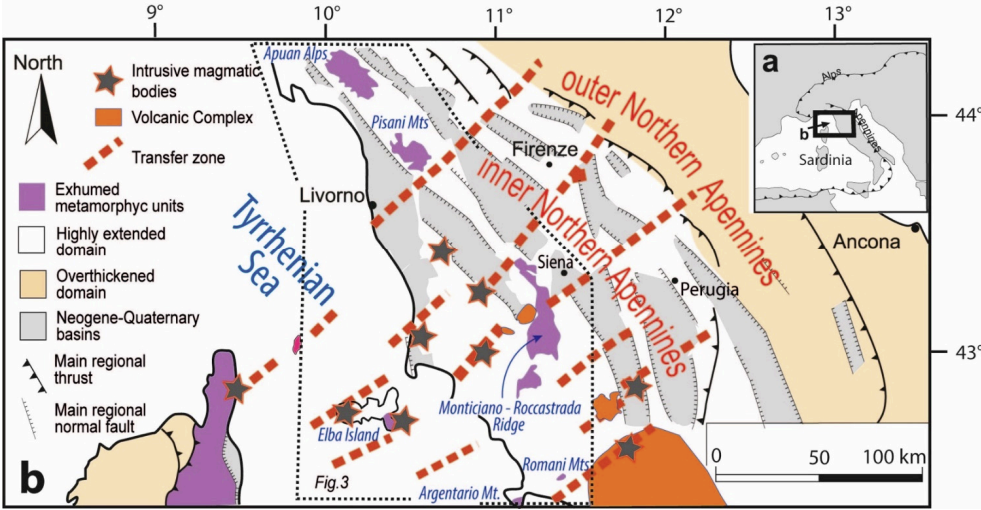
Structural sketch map of (a) the Northern Apennines and (b) Northern Tyrrhenian Sea. (Picture from Capezzuoli et al., 2021).
The tectonic evolution in this area involves detachment levels, particularly at the base of the Jurassic-Miocene sedimentary cover, which has created lateral permeable levels. Elba and Larderello share a comparable rock succession, belonging to the same paleogeographic domains and tectonic evolution (Carmignani et al., 2004). The Elba geothermal system, exposed due to exhumation and uplift processes, sheds light on the Larderello system at depth through analogy.
The Porto Azzurro monzogranite exhibited multiple generations of faults within a transfer zone situated on the southeastern side of the island (Liotta et al., 2015). This characteristic closely corresponds with the inland tectonic context, as evidenced in studies such as Liotta and Brogi (2020). These faults are associated with zones of damage hosting mineralized shear veins, indicating concurrent activities involving fluid movement and faulting processes (Zucchi et al., 2019).
The methodological approach employed in analyzing exhumed analogs of active geothermal systems contributes significantly to understanding the physical state and dynamics of such conductive-convective geothermal systems (Santilano et al., 2015). This approach illuminates the complex interplay among geological structures, fluid movement pathways, and mineralization, notably in areas such as Elba and Larderello. Its application significantly assists in developing a reliable predictive model for the exploration of active geothermal systems.
For further exploration on this topic, take a look at:
Bertini, G.; Gianelli, G.; Pandeli, E.; Puxeddu, M. Distribution of hydrothermal minerals in the Larderello-Travale and Mt. Amiata geothermal fields (Italy). Geotherm. Res. Counc. Trans. 1985, 9, 261–266.
Brogi, A.; Alçiçek, M.C.; Liotta, D.; Capezzuoli, E.; Zucchi, M.; Matera, P.F. Step-over fault zones controlling geothermal fluid-flow
Brogi, A.; Fulignati, P. Tectonic control on hydrothermal circulation and fluid evolution in the Pietratonda-Poggio Peloso (southern Tuscany, Italy) carbonate-hosted Sb-mineralization. Ore Geol. Rev. 2012, 44, 158–171.
Bianco, C.; Godard, G.; Halton, A.; Brogi, A.; Liotta, D. and Caggianelli, A., (2019). The lawsonite-glaucophane blueschists of Elba Island (Italy). Lithos, 348-349, article no. 105198.
Capezzuoli, E.; Spina, A.; Brogi, A.; Liotta, D.; Bagnoli, G.; Zucchi, M.; Molli, G.; Regoli, R. Reconsidering the Variscan Basement of Southern Tuscany (Inner Northern Apennines). Geosciences 2021, 11, 84. https://doi.org/10.3390/geosciences11020084
Carmignani L., Conti P., Cornamusini G., Meccheri M. (2004). The Internal Northern Apennines, The Northern Tyrrhenian Sea And The Sardinia-Corsica Block. Special Volume of the Italian Geological Society for the IGC 32 Florence-2004
Dini, A.; Gianelli, G.; Puxeddu, M.; Ruggieri, G. Origin and evolution of Pliocene–Pleistocene granites from the Larderello geothermal field (Tuscan Magmatic Province, Italy). Lithos 2005, 81, 1–31.
Liotta D. 1991. “The Arbia-Val Marecchia Line, Northern Apennines”. Eclogae Geologica Helvetiae, 84, 413–430.
Liotta D., Brogi, A., (2020) – Pliocene-Quaternary fault kinematics in the Larderello geothermal area (Italy): Insights for the interpretation of the present stress field. Geothermics 83, 101714
Liotta, D.; Brogi, A.; Ruggieri, G.; Zucchi, M. Fossil vs. Active Geothermal Systems: A Field and Laboratory Method to Disclose the Relationships between Geothermal Fluid Flow and Geological Structures at Depth. Energies 2021, 14, 933. https:// doi.org/10.3390/en14040933.
Santilano, A., Manzella, A., Gianelli, G., Donato, A., Gola, G., Nardini, I., Trumpy, E., Botteghi, S. (2015) – Convective, Intrusive Geothermal Plays: what about tectonics? Geothermal Energy Science, 3, 51-59. doi:10.5194/gtes-3-51-2015.
Tanelli, G.; Benvenuti, M.; Costagliola, P.; Dini, A.; Lattanzi, P.; Maineri, C.; Macaro, I.; Ruggieri, G. The iron mineral deposits of Elba Island: State of the art. Ofioliti 2001, 26, 239–248.
Zucchi, M.; Brogi, A.; Liotta, D.; Rimondi, V.; Ruggieri, G.; Montegrossi, G.; Caggianelli, A.; Dini, A. Permeability and hydraulic conductivity of faulted micaschist in the eastern Elba Island exhumed geothermal system (Tyrrhenian sea, Italy): Insights from Cala Stagnone. Geothermics 2017, 70, 125–145.
Zucchi M., Caggianelli A., Brogi A., Liotta D., Spiess R. & Ruggieri G. (2019) – Skarn development in calcareous-pelitic succession affected by thermal metamorphism and fluid flow at Acquarilli beach (Elba Island, Italy). International Journal of Earth Sciences volume 108, pages2603–2605(2019).


